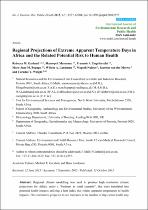 ResearchSpace
ResearchSpace
Regional Projections of Extreme Apparent Temperature Days in Africa and the Related Potential Risk to Human Health
JavaScript is disabled for your browser. Some features of this site may not work without it.
- ResearchSpace
- →
- Research Publications/Outputs
- →
- Journal Articles
- →
- View Item
| dc.contributor.author |
Garland, Rebecca M

|
|
| dc.contributor.author |
Matooane, M

|
|
| dc.contributor.author |
Engelbrecht, FM

|
|
| dc.contributor.author |
Bopape, Mary-Jane M

|
|
| dc.contributor.author |
Landman, WA

|
|
| dc.contributor.author |
Naidoo, M

|
|
| dc.contributor.author |
Van der Merwe, J

|
|
| dc.contributor.author |
Wright, CY

|
|
| dc.date.accessioned | 2016-09-07T10:56:50Z | |
| dc.date.available | 2016-09-07T10:56:50Z | |
| dc.date.issued | 2015-10 | |
| dc.identifier.citation | Garland, R.M., Matooane, M., Engelbrecht, F.A., Bopape, M.M., Landman, W.A., Naidoo M., van der Merwe, J. and Wright, C.Y. 2015. Regional Projections of Extreme Apparent Temperature Days in Africa and the Related Potential Risk to Human Health. In: International Journal of Environmental Research and Public Health, vol, 12(10), p.p. 12577-12604 | en_US |
| dc.identifier.issn | 1660-4601 | |
| dc.identifier.uri | http://www.mdpi.com/1660-4601/12/10/12577/htm | |
| dc.identifier.uri | http://hdl.handle.net/10204/8761 | |
| dc.description | Copyright: 2015 MDPI | en_US |
| dc.description.abstract | Regional climate modelling was used to produce high resolution climate projections for Africa, under a “business as usual scenario”, that were translated into potential health impacts utilizing a heat index that relates apparent temperature to health impacts. The continent is projected to see increases in the number of days when health may be adversely affected by increasing maximum apparent temperatures (AT) due to climate change. Additionally, climate projections indicate that the increases in AT results in a moving of days from the less severe to the more severe Symptom Bands. The analysis of the rate of increasing temperatures assisted in identifying areas, such as the East African highlands, where health may be at increasing risk due to both large increases in the absolute number of hot days, and due to the high rate of increase. The projections described here can be used by health stakeholders in Africa to assist in the development of appropriate public health interventions to mitigate the potential health impacts from climate change. | en_US |
| dc.language.iso | en | en_US |
| dc.publisher | MDPI | en_US |
| dc.relation.ispartofseries | Workflow;16286 | |
| dc.subject | Climate change | en_US |
| dc.subject | Climate services | en_US |
| dc.subject | Human health | en_US |
| dc.subject | Regional climate modelling | en_US |
| dc.title | Regional Projections of Extreme Apparent Temperature Days in Africa and the Related Potential Risk to Human Health | en_US |
| dc.type | Article | en_US |
| dc.identifier.apacitation | Garland, R. M., Matooane, M., Engelbrecht, F., Bopape, M. M., Landman, W., Naidoo, M., ... Wright, C. (2015). Regional Projections of Extreme Apparent Temperature Days in Africa and the Related Potential Risk to Human Health. http://hdl.handle.net/10204/8761 | en_ZA |
| dc.identifier.chicagocitation | Garland, Rebecca M, M Matooane, FM Engelbrecht, Mary-Jane M Bopape, WA Landman, M Naidoo, J Van der Merwe, and CY Wright "Regional Projections of Extreme Apparent Temperature Days in Africa and the Related Potential Risk to Human Health." (2015) http://hdl.handle.net/10204/8761 | en_ZA |
| dc.identifier.vancouvercitation | Garland RM, Matooane M, Engelbrecht F, Bopape MM, Landman W, Naidoo M, et al. Regional Projections of Extreme Apparent Temperature Days in Africa and the Related Potential Risk to Human Health. 2015; http://hdl.handle.net/10204/8761. | en_ZA |
| dc.identifier.ris | TY - Article AU - Garland, Rebecca M AU - Matooane, M AU - Engelbrecht, FM AU - Bopape, Mary-Jane M AU - Landman, WA AU - Naidoo, M AU - Van der Merwe, J AU - Wright, CY AB - Regional climate modelling was used to produce high resolution climate projections for Africa, under a “business as usual scenario”, that were translated into potential health impacts utilizing a heat index that relates apparent temperature to health impacts. The continent is projected to see increases in the number of days when health may be adversely affected by increasing maximum apparent temperatures (AT) due to climate change. Additionally, climate projections indicate that the increases in AT results in a moving of days from the less severe to the more severe Symptom Bands. The analysis of the rate of increasing temperatures assisted in identifying areas, such as the East African highlands, where health may be at increasing risk due to both large increases in the absolute number of hot days, and due to the high rate of increase. The projections described here can be used by health stakeholders in Africa to assist in the development of appropriate public health interventions to mitigate the potential health impacts from climate change. DA - 2015-10 DB - ResearchSpace DP - CSIR KW - Climate change KW - Climate services KW - Human health KW - Regional climate modelling LK - https://researchspace.csir.co.za PY - 2015 SM - 1660-4601 T1 - Regional Projections of Extreme Apparent Temperature Days in Africa and the Related Potential Risk to Human Health TI - Regional Projections of Extreme Apparent Temperature Days in Africa and the Related Potential Risk to Human Health UR - http://hdl.handle.net/10204/8761 ER - | en_ZA |





